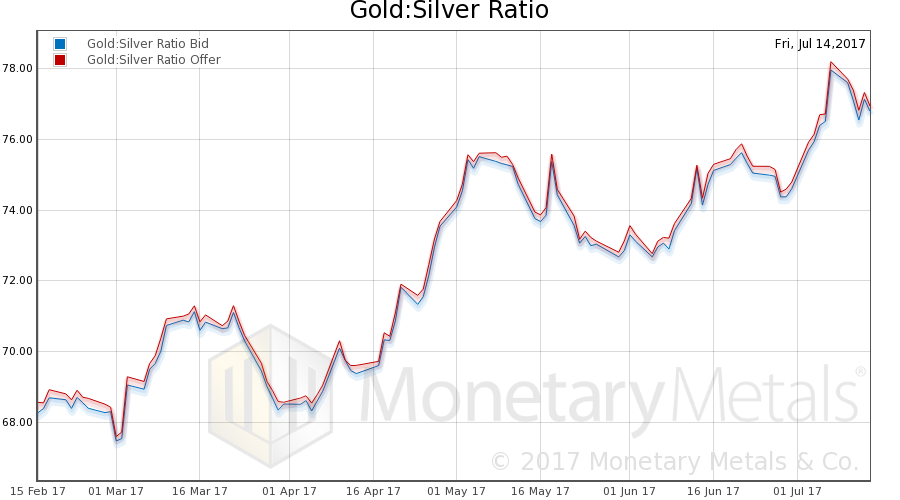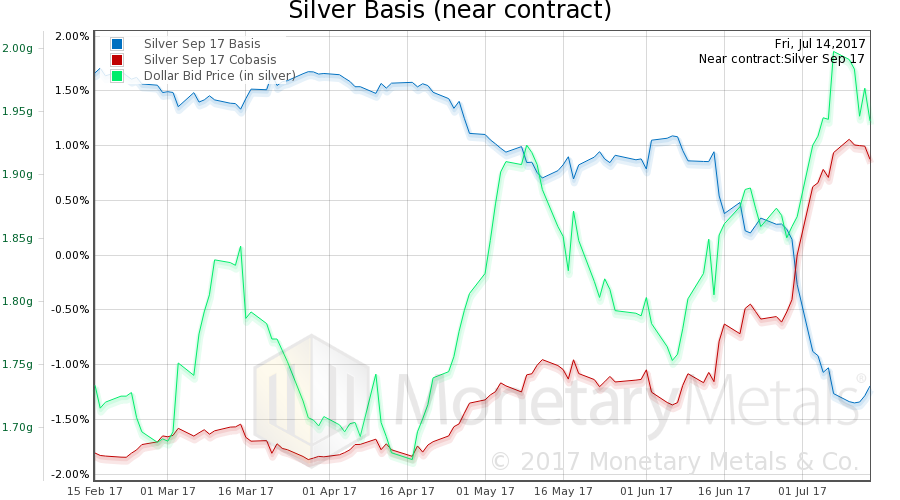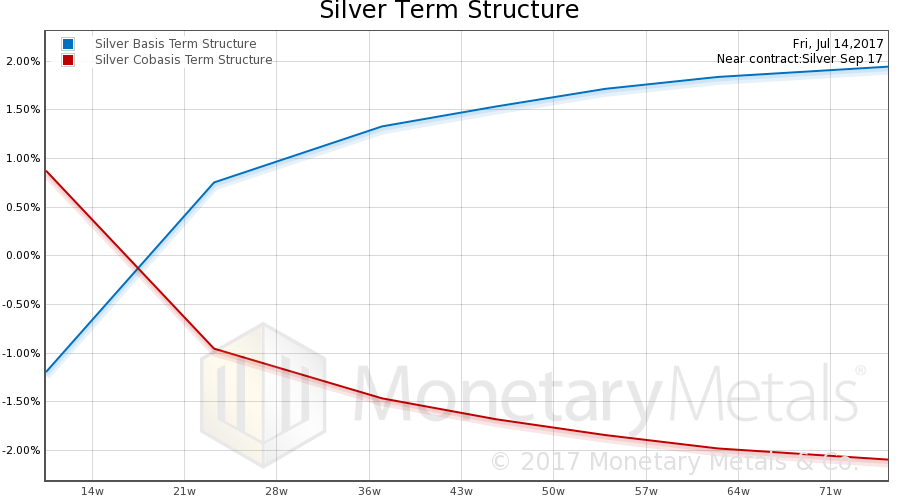Hostages of Irredeemable Scrip Stockholm Syndrome is defined as “…a condition that causes hostages to develop a psychological alliance with their captors as a survival strategy during captivity.” While observers would expect kidnapping victims to fear and loathe the gang who imprison and threaten them, the reality is that some don’t. There is a loose analogy between being held hostage and being an investor in a regime of irredeemable paper currency and zero interest rates. In both cases, the victim has little hope of escape and must seek to somehow survive under malevolent conditions. Key behaviors displayed by victims of Stockholm Syndrome are positive feelings for their captors, a refusal to work with law
Topics:
Keith Weiner considers the following as important: Chart Update, dollar price, Featured, Gold, Gold and its price, Gold and silver prices, gold basis, Gold co-basis, gold price, gold silver ratio, newslettersent, Precious Metals, silver, silver basis, Silver co-basis, silver price
This could be interesting, too:
Nachrichten Ticker - www.finanzen.ch writes Die Performance der Kryptowährungen in KW 9: Das hat sich bei Bitcoin, Ether & Co. getan
Nachrichten Ticker - www.finanzen.ch writes Wer verbirgt sich hinter der Ethereum-Technologie?
Marc Chandler writes March 2025 Monthly
Mark Thornton writes Is Amazon a Union-Busting Leviathan?
Hostages of Irredeemable ScripStockholm Syndrome is defined as “…a condition that causes hostages to develop a psychological alliance with their captors as a survival strategy during captivity.” While observers would expect kidnapping victims to fear and loathe the gang who imprison and threaten them, the reality is that some don’t. There is a loose analogy between being held hostage and being an investor in a regime of irredeemable paper currency and zero interest rates. In both cases, the victim has little hope of escape and must seek to somehow survive under malevolent conditions. Key behaviors displayed by victims of Stockholm Syndrome are positive feelings for their captors, a refusal to work with law enforcement afterward, and even a belief in the humanity of the terrorists. Key behaviors of investors today show eerie parallels: a desire to bid on dollars with their assets, a refusal to support the gold standard, and even a belief that the dollar is money. This last always shows when someone — even a gold bug — says gold is going up, or gold is the best performing currency, or gold has good returns. |
 Images from the Kreditbanken robbery at Norrmalmstorg in central Stockholm in 1973. The two bank robbers took four hostages, who afterward complained that they were far more scared of the what the police might do than of the robbers. - Click to enlarge One of the hostages even struck up a personal friendship with one of the hostage takers a few years later (despite the fact that he remained a career criminal). Psychologists became interested in this odd behavior and criminologist Nils Bejerot eventually coined the term “Stockholm syndrome” to describe it. [PT] |
| These words up, performance, and returns indicate that the victim accepts the dollar as money, the dollar as the measure of value, the dollar as the unit of account. The victim seeks to view gold in terms of his captor’s paradigm. Much like the kidnapping victim seeks to understand his capture and even geopolitics in terms of his captor’s world view.
Many victims are so thoroughly in thrall, that they scoff at the very idea of earning interest from a productive enterprise. They seek only the latest bubble, where they can make a profit: more dollars. Or, if not more dollars, at least more purchasing power. For years, they sought to do this in the gold and especially silver markets. Some gold bugs go even farther, and oppose a gold standard. Perhaps they don’t want sound money, they want gold to go up which means something external that gold can go up against. |
 A pile of external somethings, i.e., legal tender made from dead trees. As long as it is used and accepted as a general medium of exchange people will pine for it. - Click to enlarge Government scrip derives its secondary market value primarily from the fact that it is the only form of money accepted for the payment of taxes. [PT] |
| We watched bemused as a speaker at the Metal Writers Conference in Vancouver on May 29 told a standing-room-only crowd that bitcoin would hit $1 million (it went up after that, but is now down about 15% from that day). A 436X return would be nice, but of course the profits can only come from later speculators.
There is an ugly little word for schemes in which profits come from those who buy in later. It is named for a gentleman who came from Italy, promoting his scheme in Boston. We blame the game, not the player. It is important to emphasize this—don’t blame the players, blame the game — and we probably don’t do it enough. The fault lies not with those who bet on gold or bitcoin or anything else, nor even with those who regard betting as investing. The fault lies with the Fed and the other central banks who have the hubris to think they can centrally plan their way to prosperity. And the gun to force it on us, whether we agree or not. And the madness to cause interest rates to fall for 36 years and counting (the Fed is not going to push the interest up much farther in this cycle, if they even dare to implement one more hike). When freedom seems so remote as to be hopeless, it may be natural (we leave this to psychologists to determine) to find a way to compromise, to get along to go along. As to us, we will go on working towards that day of freedom, a big part of which is helping people see the monetary system for what it is: the current implementation of the fifth plank proposed by Karl Marx. Another part is to pay interest on gold… |
 Charles Ponzi at his desk in 1920. His comprehensive get-rich-quick scheme eventually brought down six banks in Boston and impoverished thousands of gullible investors. - Click to enlarge About 75% of the members of Boston’s police force had invested in his scheme as well. [PT] Photo credit: Boston Library |
Fundamental Developments
Last week, the prices of the metals bounced somewhat, within their recent trading range. Gold closed at $1212 the previous week, and last week at $1229. In silver, the previous week’s close was $15.56, and last week’s was $15.96. Will the bounce continue? Have the fundamentals firmed up? We will show graphs of the true measure of the fundamentals. But first charts of their prices and the gold-silver ratio. |
Gold and Silver Prices(see more posts on gold price, silver price, ) |
Gold:Silver RatioNext, this is a graph of the gold price measured in silver, otherwise known as the gold to silver ratio. The ratio moved down last week.
|
Gold:Silver Ratio(see more posts on gold silver ratio, ) |
Gold Basis and Co-basis and the Dollar PriceHere is the gold graph. The dollar fell a bit this week (the mirror image of the rising price of gold). Now it is the dollar hostages who use gold as their preferred hostage-bargaining chip to feel a bit better. One ounce of this commodity now fetches 17 more of the kidnapper’s paper scrip than it did a week ago. As the dollar fell, the co-basis fell (especially in farther-out contracts). The August co-basis is still above zero (i.e. there is a temporary backwardation in place). Our calculated gold fundamental price has not changed much, it remains above the market price by a goodly margin (chart here). |
Gold Basis and Co-basis and the Dollar Price(see more posts on dollar price, gold basis, Gold co-basis, ) |
Silver Basis and Co-basis and the Dollar PriceNow let’s look at silver. As the dollar has dropped (i.e., silver trades for more gang-scrip than last week), the co-basis has come down. But it is still higher than gold’s co-basis, and this is the September contract, a month further from expiry than the August gold contract. Our calculated silver fundamental price is rising again, also maintaining a healthy margin above the market price. We thought it would be worth addressing the question: “is there a shortage in silver?” Let’s do it with a device that’s famously worth 1,000 words. This picture shows the term structure of the silver futures market. |
Silver Basis and Co-basis and the Dollar Price(see more posts on dollar price, silver basis, Silver co-basis, ) |
| What we see is what Sherlock Holmes observed that people heard in the night in the story Silver Blaze. There are no interesting features. Other than the temporary backwardation in the September contract, we see a rising basis and falling co-basis as we look out to December 2018. The rising basis looks a lot like the yield curve in the dollar, though it is slightly lower (6-month LIBOR is 1.5%).
If a real shortage developed in silver, the above curve would look quite different. And we would be publishing pictures of it. |
Silver Basis and Co-basis(see more posts on silver basis, Silver co-basis, ) |
Monetary Metals will be exhibiting at Freedom Fest in Las Vegas in July. If you are an investor and would like a meeting there, please click here. Keith will be speaking, on the topic of what will the coming gold standard look like.
Tags: Chart Update,dollar price,Featured,Gold,Gold and silver prices,gold basis,Gold co-basis,gold price,gold silver ratio,newslettersent,Precious Metals,silver,silver basis,Silver co-basis,silver price





